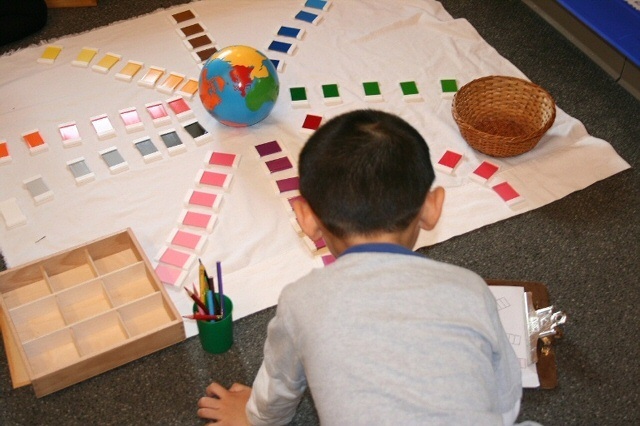The Most Commonly Asked Questions About Montessori
 What happens during work time?
What happens during work time?
As work time begins, children move around the classroom freely. Some spend a long time looking around, seeing what the other children are doing and investigating the shelves. Others choose a "work" they have been practicing and which is the current favorite. Sometimes an activity takes only a few minutes, and children move relatively quickly from one task to the next. Other activities are complex and involved and can take several class periods to complete. During work time, the assistant teacher is moving around the class, helping direct children, answering requests and generally keeping children on-task and focused. The head teacher observes the class as a whole, watching as children practice lessons given previously and noting skill levels. At the same time, the head teacher sees opportunities for presenting new lessons, and will invite a single child or a small group to join her.
How does the teacher teach 20 children individually?
The teacher introduces works to each child as she feels he is ready. Each child gets attention from the teacher each day, though this is not always a "new" lesson. The Montessori environment is designed both to let children "discover" knowledge and to have it "taught" to them. Once a lesson is presented, a child can choose that activity and pursue it on his own. Over several work periods, children develop a repertoire of works they can choose at will. The teacher watches how they do, and may add a new part to the lesson. As a child masters one part of, say, the math sequence, the teacher begins to introduce new lessons. Also, there are "group" lessons each day at circle, addressing classroom business, science and cultural lessons, sharing, and language development.
Is Montessori "all work and no play"?
It is important to keep in mind that a child's "work" is very different from what an adult would call work. Adult work implies an obligation. Sometimes our work is interesting, sometimes it's unpleasant. Adult work is task-focused and goal-oriented. A child's "work" is by contrast process-oriented, and helps the child acquire skills and build character. A child's work is joyful, spontaneous and energizing. Also, each classroom provides a range of activities, from casual, open-ended to challenging. There is of course, unstructured play time each class period as well as work time. So, in Montessori we call the child's process "work" as a sign of respect for the seriousness of what each child is trying to accomplish. "Work" is much more than being busy and entertained: it is the process of self-creation, the laying of the foundation for a keen intellect and a happy, productive life.
What about socialization?
The Montessori method is a holistic approach to child development, and recognizes both solitude and gregariousness as part of human nature. Individual work allows time for thinking things through and developing concentration. Social development is also a primary aspect of each day. Learning social skills is a complex process. Children need opportunities to practice communicating, problem solving, and cooperating, and they need models for appropriate interaction. Teachers guide children through social situations by offering examples. During work time, children often work together, cooperating and negotiating about how to complete a task. Children also chat with friends at the same table while each is doing their own work. They share ideas, stories, and help each other when needed. There is also group time each day, on the playground and in the circle.
What about self-esteem?
Self-esteem in the Montessori classroom is two-fold. First, each child is accepted for who they are unconditionally, and is given love and respect. Secondly, each child is guided through successful learning and social experiences, which over time accumulate into a general feeling of self-worth and competence. Children learn to take risks, to ask for help, and to offer help to others in what becomes a beautifully cooperative community where each child has an important place and purpose.
What makes the Montessori materials so special and so important?
Most of what a child learns in a Montessori environment comes from interacting with specially designed materials. Children learn a great deal without being "taught", a process that encourages self-motivation and independence. The materials are precise. Materials are also aesthetically designed to attract children, and invite them to spend time with the activity.
How does Montessori address the development of the imagination?
The basic components of a Montessori curriculum are essential for developing creative as well as critical thinking because these materials order the child’s sensory experience. "The environment must itself be beautiful, harmonious, and based on reality in order for the child to organize his perceptions of it. When he has developed realistic and ordered perceptions of the life about him, the child is capable of the selecting and emphasizing processes necessary for creative endeavors." (Paula Polk-Lillard, Montessori, A Modern Approach, p.45.) Imagination is an intellectual capacity that is a natural part of the child’s development. Our guidance for dealing with exercise of the imagination is the same as for other areas of intellectual/developmental growth. We observe the child, act as a guide to connect the child to the tools needed, and stay out of the content. Imagination for the young child will relate to that child’s experience, and should come from the child, not the teacher. The same is true for the role of fantasy in a child’s life. If the child initiates fantasy/imaginative play, it is expected that the teacher observes for classroom management and interferes as little as possible. Our role is neither to discourage nor encourage content of child’s play except around violence, meanness and other grace and courtesy issues.

